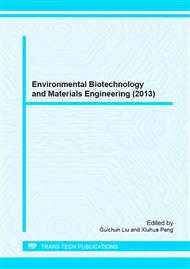[1]
E.M. Zahran, D. Bhattacharyya, L.G. Bachas, Development of reactive Pd/Fe bimetallic nanotubes for dechlorination reactions, J. Mater. Chem. 21 (2011) 10454-10462.
DOI: 10.1039/c1jm11435b
Google Scholar
[2]
C.C. Qiu, X.Q. Dong, M.H. Huang, et al, Facile fabrication of nanostructured Pd-Fe bimetallic thin films and their electro dechlorination activity, J. Mol. Catal. A: Chem. 350 (2011) 56-63.
DOI: 10.1016/j.molcata.2011.09.004
Google Scholar
[3]
L.M. Kustov, E.D. Finashina, E.V. Shuvalova, et al, Pd–Fe nanoparticles stabilized by chitosan derivatives for perchloroethene dechlorination, Environ. Int. 37 (2011) 1044-1052.
DOI: 10.1016/j.envint.2011.05.003
Google Scholar
[4]
J.J. Zhan, B. Sunkara, J.J. Tang, et al, Carbothermal Synthesis of Aerosol-Based Adsorptive-Reactive Iron-Carbon Particles for the Remediation of Chlorinated Hydrocarbons, Ind. Eng. Chem. Res. 50 (2011) 13021-13029.
DOI: 10.1021/ie200783z
Google Scholar
[5]
H. Ma, Y.P. Huang, M.W. Shen, et al, Enhanced dechlorination of trichloroethylene using electrospun polymer nanofibrous mats immobilized with iron/palladium bimetallic nanoparticles, J. Hazard. Mater. 211-212 (2012) 349-356.
DOI: 10.1016/j.jhazmat.2011.11.038
Google Scholar
[6]
G.K. Parshetti, R.A. Doong, Dechlorination of trichloroethylene by Ni/Fe nanoparticles immobilized in PEG/PVDF and PEG/nylon 66 membranes, Water Res. 43 (2009) 3086-3094.
DOI: 10.1016/j.watres.2009.04.037
Google Scholar
[7]
F. He, D.Y. Zhao, J.C. Liu, et al, Stabilization of Fe−Pd Nanoparticles with Sodium Carboxymethyl Cellulose for Enhanced Transport and Dechlorination of Trichloroethylene in Soil and Groundwater, Ind. Eng. Chem. Res. 46 (2007) 29-34.
DOI: 10.1021/ie0610896
Google Scholar
[8]
S.H. Joo, D.Y. Zhao, Destruction of lindane and atrazine using stabilized iron nanoparticles under aerobic and anaerobic conditions: Efects of catalyst and stabilizer, Chemosphere. 70 (2008) 418-425.
DOI: 10.1016/j.chemosphere.2007.06.070
Google Scholar
[9]
Y.C. Cho, S. Choi, Degradation of PCE, TCE and 1, 1, 1-TCA by nanosized FePd bimetallic particles under various experimental conditions, Chemosphere. 81 (2010) 940-945.
DOI: 10.1016/j.chemosphere.2010.07.054
Google Scholar
[10]
N. Sakulchaicharoen, D.M. O'Carroll, J.E. Herrera, Enhanced Stability and Dechlorination Activity of pre-synthesis stabilized Nanoscale Fe/Pd Particles, J. Contam. Hydrol. 118 (2010) 117-127.
DOI: 10.1016/j.jconhyd.2010.09.004
Google Scholar
[11]
D.H. Phillips, B. Gu, D.B. Watson, et. al, Performance evaluation of a zerovalent iron reactive barrier: Mineralogical characteristics, Environ. Sci. Technol. 34 (2000) 4169-4176.
DOI: 10.1021/es001005z
Google Scholar
[12]
F. He, D.Y. Zhao, C. Paul, Field assessment of carboxymethyl cellulose stabilized iron nanoparticles for in situ destruction of chlorinated solvents in source zones, Water Res. 44 (2010) 2360-2370.
DOI: 10.1016/j.watres.2009.12.041
Google Scholar
[13]
Y.T. Wei, S. Wu, S.W. Yang, et al, Biodegradable surfactant stabilized nanoscale zero-valent iron for in situ treatment of vinyl chloride and 1, 2-dichloroethane, J. Hazard. Mater. 211-212 (2012) 373-380.
DOI: 10.1016/j.jhazmat.2011.11.018
Google Scholar
[14]
J. Morales, R. Hutcheson, I.F. Cheng, Dechlorination of chlorinated phenols by catalyzed and uncatalyzed Fe(0) and Mg(0) particles, J. Hazard. Mater. 90 (2002) 97-108.
DOI: 10.1016/s0304-3894(01)00336-3
Google Scholar
[15]
J.H. Choi, Reductive Dechlorination of Chlorinated Phenols Using Zero-valent Metal and Bimetal Systems: Kinetics and Sequential Permeable Reactive Barrier, Ph.D. Dissertation, 2004, Kyungpook National University, Korea.
Google Scholar
[16]
T.T. Dong, H.J. Luo, Y.P. Wang, et al, Stabilization of Fe-Pd bimetallic nanoparticles with sodium carboxymethyl cellulose for catalytic reduction of para-nitrochlorobenzene in water, Desalination. 271 (2011) 11-19.
DOI: 10.1016/j.desal.2010.12.003
Google Scholar
[17]
H.Y. Zhou, J. Han, S.A. Baig, et al, Dechlorination of 2, 4-dichlorophenoxyacetic acid by sodium carboxymethyl cellulose-stabilized Pd/Fe nanoparticles, J. Hazard. Mater. 198 (2011) 7-12.
DOI: 10.1016/j.jhazmat.2011.10.002
Google Scholar


